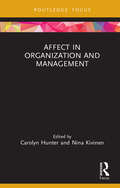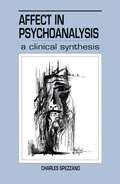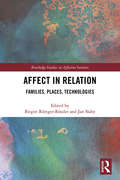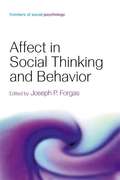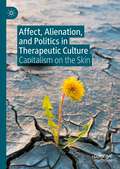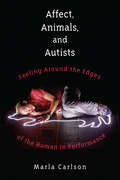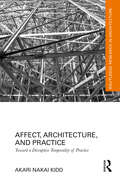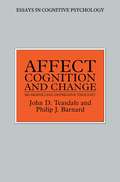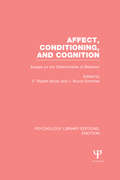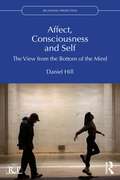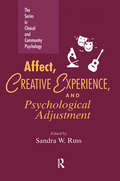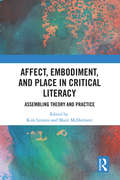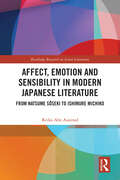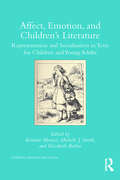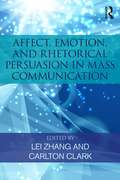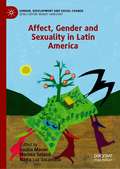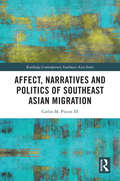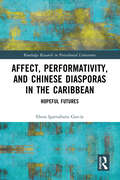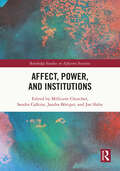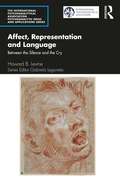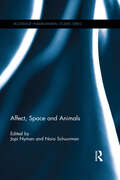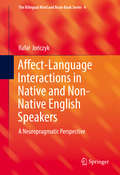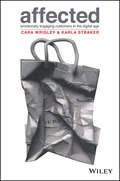- Table View
- List View
Affect in Organization and Management (Routledge Focus on Women Writers in Organization Studies)
by Carolyn Hunter Nina KivinenAffect in Organization and Management asks how affect theory understands everyday working lives through embodied, social and political practice. Discussing a range of dimensions and perspectives on affect, the book considers how subjects are formed through their connections with others, both human and non- or more-than-human. The six women writers on affect presented in this series (Sara Ahmed, Kathleen Stewart, Donna Haraway, Jane Bennett, Karen Barad and Rosalyn Diprose) all speak to important themes in organization studies, including power, politics and ethics. Each chapter explores how these thinkers have already influenced organization scholars, as well as how their work can extend our understanding of pressing organizational issues around gender, race, the environment, leadership and ethics. Feminism is a core feature of this collection, highlighting feminist writing with affective, connected and intersubjective possibilities. Each woman writer is introduced by experts on affect and organization studies. The chapters also suggest further reading and accessible resources. The book is suitable for students, academics and practitioners in business and management, organization studies and critical management studies who want to think differently about organizations.
Affect in Psychoanalysis: A Clinical Synthesis (Relational Perspectives Book Series)
by Charles SpezzanoDrawing on the writings of Freud, Fairbairn, Klein, Sullivan, and Winnicott, Spezzano offers a radical redefinition of the analytic process as the intersubjective elaboration and regulation of affect. The plight of analytic patients, he holds, is imprisonment within crude fantasy elaborations of developmentally significant feeling states. Analytic treatment fosters the patient's capacity to keep alive in consciousness, and hence reflect on, these previously warded-off affective states; it thereby provides a second chance to achieve competence in using feeling states to understand the self within its relational landscape.
Affect in Relation: Families, Places, Technologies (Routledge Studies in Affective Societies)
by Birgitt Röttger-Rössler Jan SlabyDecades of research on affect and emotion have brought out the paramount importance of affective processes for human lives. Affect in Relation brings together perspectives from social science and cultural studies to analyze the formative, subject constituting potentials of affect and emotion. Relational affect is understood not as individual mental states, but as social-relational processes that are both formative and transformative of human subjects. This volume explores relational affect through a combination of interdisciplinary case studies within four key contexts: Part I: “Affective Families” deals with the affective dynamics in transnational families who are scattered across several regions and nations. Part II: “Affect and Place” brings together work on affective place-making in the contexts of migration and in political movements. Part III: “Affect at Work” analyzes the affective dimension of contemporary white-collar workplaces. Part IV: “Affect and Media” focuses on the role of media in the formation and mobilization of relational affect. In its transdisciplinary spirit, analytical rigor and focus on timely and salient global matters, Affect in Relation consolidates the field of affect studies and opens up new avenues for scholarly and practical co-operation. It will appeal to both students and postdoctoral researchers interested in fields such as anthropology, sociology, cultural studies, media studies and human development.
Affect in Social Thinking and Behavior (Frontiers of Social Psychology)
by Joseph P. ForgasThe role of affect in how people think and behave in social situations has been a source of fascination to laymen and philosophers since time immemorial. Surprisingly, most of what we know about the role of feelings in social thinking and behavior has been discovered only during the last two decades. Affect in Social Thinking and Behavior reviews and integrates the most recent research and theories on this exciting topic, and features original contributions reviewing key areas of affect research from leading researchers active in the area.The book covers fundamental issues, such as the nature and relationship between affect and cognition, as well as chapters that deal with the cognitive antecedents of emotion, and the consequences of affect for social cognition and behavior.This volume offers a highly integrated and comprehensive coverage of this field, and is suitable as a core textbook in advanced courses dealing with the role of affect in social cognition and behavior.
Affect, Alienation, and Politics in Therapeutic Culture: Capitalism on the Skin
by Suvi SalmenniemiThis book contributes to research on therapeutic culture by drawing on longstanding ethnographic work and by offering a new theoretical reading of therapeutic culture in today's society. It suggests that the therapeutic field serves as a key site in which a number of contradictions of capitalism are confronted and lived out. It shows that therapeutic engagements are inherently ambivalent and contradictory, as they can be articulated and engaged with in many different ways and harnessed for diverse, and often contradictory, political projects. The book takes issue with the interpretation of therapeutic culture as merely individualising, depoliticizing and working in congruence with neoliberalism, and shows that therapeutic engagements may also open up a space for contestation and critique of neoliberal capitalism, animate collective action for social change and articulate alternative forms of life and subjectivities. The book will speak to a wide variety of audiences in the social sciences and will be of particular interest to those working in the fields of sociology, anthropology, critical psychology, cultural studies, gender studies, and critical social theory.
Affect, Animals, and Autists: Feeling Around the Edges of the Human in Performance
by Marla CarlsonWhen theater and related forms of live performance explore the borderlands labeled animal and autism, they both reflect and affect their audiences’ understanding of what it means to be human. Affect, Animals, and Autists maps connections across performances that question the borders of the human whose neurodiverse experiences have been shaped by the diagnostic label of autism, and animal-human performance relationships that dispute and blur anthropocentric edges. By analyzing specific structures of affect with the vocabulary of emotions, Marla Carlson builds upon the conception of affect articulated by psychologist Silvan Tomkins. The book treats a diverse selection of live performance and archival video and analyzes the ways in which they affect their audiences. The range of performances includes commercially successful productions such as The Curious Incident of the Dog in the Night-Time, War Horse, and The Lion King as well as to the more avant-garde and experimental theater created by Robert Wilson and Christopher Knowles, Back to Back Theatre, Elevator Repair Service, Pig Iron Theatre, and performance artist Deke Weaver.
Affect, Architecture, and Practice: Toward a Disruptive Temporality of Practice (Routledge Research in Architecture)
by Akari Nakai KiddAffect, Architecture, and Practice builds on and contributes to work in theories of affect that have risen within diverse disciplines, including geography, cultural studies, and media studies, challenging the nature of textual and representational-based research. Although numerous studies have examined how affect emerges in architectural spaces, little attention has been paid to the creative process of architectural design and the role that affect plays in the many contingencies and uncertainties that arise in the process. The book traces the critical, philosophic, and architectural theories to examine how affect, architecture, and practice are interlinked. Through a series of conversations and reflections, it examines three key contemporary architects, their practices and projects, all within a single coherent theme. Reiser + Umemoto (RUR Architecture DPC), USA, Kerstin Thompson Architects, Australia, and Shigeru Ban Architects, Japan, are critically studied through the lens of different aspects of practice, namely image-making, the design process, and the making of an everyday object/material. Through this investigation, author Akari Nakai Kidd demonstrates how affect theory allows a critical interrogation of the in-betweens of practice, its liminality and limits. It questions the stability of objects, the smooth temporality of practice, and its often under-conceptualised non-human dimensions. More significantly, the book demonstrates architectural practice’s contribution to the reconceptualisation of theories of affect.
Affect, Cognition and Change: Re-Modelling Depressive Thought (Essays in Cognitive Psychology)
by John Teasdale Philip BarnardThis text, a collaboration between a clinical psychologist and a cognitive psychologist, offers a cognitive account of depression.
Affect, Conditioning, and Cognition: Essays on the Determinants of Behavior (Psychology Library Editions: Emotion)
by J. Bruce Overmier F. Robert BrushOriginally published in 1985, this title was a retrospective appreciation of the late Richard L. Solomon. His pre- and postdoctoral students from past years presented the 22 papers which are published in this volume. The book reflects the breadth of Solomon’s impact through his teaching and research. The first part contains a chapter that provides a bit of history in a retrospective appreciation of the several foci of Solomon’s research career. This chapter sets the stage for those that follow and reduces their diversity by providing a degree of historical understanding. The second part on the role of properties of fear contains chapters that address various issues associated with the role of conditioned fear. The third part contains papers that address cognitive, information-processing issues in the context of Pavlovian conditioning of appetitive and aversive events, reasoning and timing. The fourth part continues the exploration of the phenomenon of learned helplessness first discovered in Solomon’s laboratory. The fifth part addresses various issues associated with the Solomon and Corbit opponent-process theory of motivation and affect. The final part, on applications to human and cultural issues, contains chapters on such diverse subjects as cross-cultural analyses of aggressive behavior in children, the analysis of resistance to change in industrial organizations, the concept of liberty in formulating research issues in developmental psychology, and the status of free will in modern American psychology.
Affect, Consciousness and Self: The View from the Bottom of the Mind (Relational Perspectives Book Series)
by Daniel HillThis book argues that mental life is organized by and around affect. It proposes a clinical model for understanding how affect influences states of consciousness and self. It illustrates how, from moment to moment, affect determines the world we know, how we are disposed to being in it, and our capacity to function in it.After introducing consciousness and self as features of mind that have posed daunting problems for philosophy, neurology, and psychoanalysis, subsequent chapters propose a model for understanding them at the clinical level. Initial chapters are devoted to the influence of affect on the structure and dynamics of normal waking consciousness and on the self’s capacity to act agentically, to relate intersubjectively, and to develop itself. Final chapters discuss disordered states of consciousness and impeded self‑functioning, due to affect dysregulation and what all this looks like in patients with preoccupied and avoidant attachment patterns.Drawing on psychoanalysis, attachment theory, interpersonal and affective neurobiology, and traumatology, this book offers a fresh perspective on the importance of affect for psychoanalysts and psychodynamic psychotherapists.
Affect, Creative Experience, And Psychological Adjustment (Series In Clinical And Community Psychology Ser.)
by Sandra W. RussFirst published in 1999. Routledge is an imprint of Taylor & Francis, an informa company.
Affect, Embodiment, and Place in Critical Literacy: Assembling Theory and Practice (Routledge Research in Education)
by Kim Lenters Mairi McDermottThis book explores the impact of sensation, affect, ethics, and place on literacy learning from early childhood through to adult education. Chapters bridge the divide between theory and practice to consider how contemporary teaching and learning can promote posthuman values and perspectives. By offering a posthuman approach to literacy research and pedagogy, Affect, Embodiment, and Place in Critical Literacy re-works the theory-practice divide in literacy education, to emphasize the ways in which learning is an affective and embodied process merging in a particular environment. Written by literacy educators and international literacy researchers, this volume is divided into four sections focussing on: Moving with sensation and affect; becoming worldmakers with ethics and difference; relationships that matter in curriculum and place; before drawing together everything in a concise conclusion. Affect, Embodiment, and Place in Critical Literacy is the perfect resource for researchers, academics, and postgraduate students in the fields of literacy education and philosophy of education, as well as those seeking to explore the benefits of a posthumanism approach when conceptualising theory and practice in literacy education.
Affect, Emotion and Sensibility in Modern Japanese Literature: From Natsume Sôseki to Ishimure Michiko (Routledge Research on Asian Literature)
by Reiko Abe AuestadThis book takes the unique approach of combining cognitive approaches with more established close-reading methods in analysing a selection of Japanese novels and a film.They are by four well-known male authors and a director (Natsume Sôseki, Shiga Naoya, Ôe Kenzaburô, Ibuse Masuji and Imamura Shôhei) and five female authors (Kirino Natsuo, Kawakami Mieko, Murata Sayaka, Tsushima Yûko, and Ishimure Michiko) from the early twentieth century up to the early millennium. It approaches the different artistic strategies that oscillate between emotional immersion and critical reflection. Inspired by new developments in cognitive theory and neuroscience, the book seeks to put a spotlight on the aspects of modern Japanese novels that were not fully appreciated earlier; the eclectic and fluid nature of the novel as a form, and the vital roles played by affects and emotions often complicated under the impact of trauma.Rejuvenating previously established cultural theories through a cognitive and emotional lens (narratology, genre theory, historicism, cultural study, gender theory, and ecocriticism), this book will appeal to students and scholars of modern literature and Japanese literature.
Affect, Emotion, and Children’s Literature: Representation and Socialisation in Texts for Children and Young Adults (Children's Literature and Culture)
by Kristine Moruzi Michelle J. Smith Elizabeth BullenThis volume explores the relationship between representation, affect, and emotion in texts for children and young adults. It demonstrates how texts for young people function as tools for emotional socialisation, enculturation, and political persuasion. The collection provides an introduction to this emerging field and engages with the representation of emotions, ranging from shame, grief, and anguish to compassion and happiness, as psychological and embodied states and cultural constructs with ideological significance. It also explores the role of narrative empathy in relation to emotional socialisation and to the ethics of representation in relation to politics, social justice, and identity categories including gender, ethnicity, disability, and sexuality. Addressing a range of genres, including advice literature, novels, picture books, and film, this collection examines contemporary, historical, and canonical children’s and young adult literature to highlight the variety of approaches to emotion and affect in these texts and to consider the ways in which these approaches offer new perspectives on these texts. The individual chapters apply a variety of theoretical approaches and perspectives, including cognitive poetics, narratology, and poststructuralism, to the analysis of affect and emotion in children’s and young adult literature.
Affect, Emotion, and Rhetorical Persuasion in Mass Communication
by Lei Zhang Carlton ClarkThis volume examines the interplay between affect theory and rhetorical persuasion in mass communication. The essays collected here draw connections between affect theory, rhetorical studies, mass communication theory, cultural studies, political science, sociology, and a host of other disciplines. Contributions from a wide range of scholars feature theoretical overviews and critical perspectives on the movement commonly referred to as "the affective turn" as well as case studies. Critical investigations of the rhetorical strategies behind the 2016 United States presidential election, public health and antiterrorism mass media campaigns, television commercials, and the digital spread of fake news, among other issues, will prove to be both timely and of enduring value. This book will be of use to advanced undergraduates, graduate students, and active researchers in communication, rhetoric, political science, social psychology, sociology, and cultural studies.
Affect, Gender and Sexuality in Latin America (Gender, Development and Social Change)
by Cecilia Macón Mariela Solana Nayla Luz VacarezzaThis book emphasizes the significance of affects, feelings and emotions in how we think about politics, gender and sexuality in Latin America. Considering the complex and even contradictory social processes that the region is experiencing today, many Latin American authors are turning to affect to find a key to understand our present situation, to revisit our history, and to imagine new possibilities for the future. This tendency has shown such a specificity and sometimes departure from northern productions that it compels us to focus more deeply on its own arguments, methods, and critical contributions. This volume features essays that explore the particularities of Latin American ways of thinking about affect and how they can shed new light into our understanding of, gender, sexuality and politics.
Affect, Learning, and Teacher Education: Getting Stuck in Social Justice (Routledge Cultural Studies in Knowledge, Curriculum, and Education)
by Erica E. Colmenares Scott JarvieThis volume inquires into student teachers’ “stuck moments”—moments of felt crisis—as they occur within the context of a university-based social justice teacher education (SJTE) program. The book complicates the notion that these stuck moments are primarily effects of a gap between theory and practice. Instead, Colmenares and Jarvie argue for a more robust conceptualization, drawing on affect theory, posthumanism, and Deleuzian scholarship. By considering what stuck moments do, and do to, student teachers, the book reimagines SJTE in ways that are both responsive to stuckness and disruptive of discourses of learning that dominate the field. Through a critique of the affective workings of learning, the authors consider how these discourses can prove counterproductive for the work of teaching for social justice. This insightful and stimulating volume will be of use to scholars, researchers, and students with interests in curriculum studies, affective approaches to education and SJTE.
Affect, Narratives and Politics of Southeast Asian Migration (Routledge Contemporary Southeast Asia Series)
by Carlos M. Piocos IIIThis book explores the politics of gendered labor migration in Southeast Asia through the stories and perspectives of Indonesian and Filipina women presented in films, fiction, and performance to show how the emotionality of these texts contribute to the emergence and vitality of women’s social movements in Southeast Asia. By placing literary and filmic narratives of Filipina and Indonesian domestic workers in Hong Kong and Singapore within existing conversations concerning migration policies, the book offers an innovative approach towards examining contemporary issues of Asian migration. Furthermore, through rich ethnographic accounts, the book unpacks themes of belonging and displacement, shame and desire, victimhood and resistance, sacrifice, and grief to show that the stories of Filipina and Indonesian migrant women don't just depict their everyday lives and practices but also reveal how they mediate and make sense of the fraught politics of gendered labor diaspora and globalization. Contributing to the "affective turn" of feminist and transnational scholarship, the book draws insight from the importance and centrality of affect, emotions, and feelings in shaping discourses on women’s subjectivity, labor, and mobility. In addition, the book demonstrates the issues of vulnerability and agency inherent in debates on social exclusion, human rights, development, and nation-building in Southeast Asia. Offering an innovative and multidisciplinary approach to analyses of Asian migration, this book will be of interest to academics in the fields of Asian Studies, literary and cultural studies, film studies, gender and women’s studies, and migration studies.
Affect, Performativity, and Chinese Diasporas in the Caribbean: Hopeful Futures (Routledge Research in Postcolonial Literatures)
by Elena Igartuburu GarcíaAffect, Performativity, and Chinese Diasporas in the Caribbean: Hopeful Futures analyzes the emergence of Chinese diasporic literature and art in the Caribbean and its diasporas in the twenty-first century. This book considers the historical and critical discourse about the Chinese diasporas in the Caribbean and proposes a textual and visual archive selecting contemporary texts that signal a changing paradigm in postcolonial literature at the turn of the twenty-first century. Whereas, historically, Chinese minorities had been erased or presented as ultimate Others, contemporary texts mobilize Chinese characters and their stories strategically to propose alternative configurations of community and belonging grounded in affective structures and contest the coloniality of national imaginaries.
Affect, Power, and Institutions (Routledge Studies in Affective Societies)
by Jan Slaby Sandra Calkins Millicent Churcher Jandra BöttgerThis volume advances a comprehensive transdisciplinary approach to the affective lives of institutions – theoretical, conceptual, empirical, and critical. With this approach, the volume foregrounds the role of affect in sustaining as well as transforming institutional arrangements that are deeply problematic. As part of its analysis, this book develops a novel understanding of institutional affect. It explores how institutions produce, frame, and condition affective dynamics and emotional repertoires, in ways that engender conformance or resistance to institutional requirements. This collection of works will be important for scholars and students of interdisciplinary affect and emotion studies from a wide range of disciplines, including social sciences, cultural studies, social and cultural anthropology, organizational and institution studies, media studies, social philosophy, aesthetics, and critical theory.
Affect, Representation and Language: Between the Silence and the Cry (The International Psychoanalytical Association Psychoanalytic Ideas and Applications Series)
by Howard B. LevineThis book presents and elaborates on the rationale and implications of the transformational dimension of psychoanalysis. In so doing, it attempts to extend psychoanalytic theory and practice beyond neurosis and beyond what were formerly thought to be the limits of analytic understanding. Its theoretical vision sits at the crossroads of the thinking of Freud, Bion, Winnicott, Green and the Paris Psycho-Somatic School. Other sources include the contributions of contemporary French psychoanalysts such as Laplanche, Donnet, L. Kahn, P. Miller and the Botellas, along with the work of Alvarez, Scarfone, Ferro, Ogden, and more. In re-examining the very epistemological foundations of psychoanalysis and their implications for a theory of psychic functioning, it follows upon and extends the radical implications of Freud’s 1937 Constructions paper, the thoughts of Bion on intuition and Winnicott’s understanding of the working through of the consequences of early pre-verbal environmental failure. In so doing, it makes a case for psychoanalysis as a powerful treatment for borderline, primitive narcissistic, post-traumatic and other character disorders and conditions – including perversions, addictions, psychosomatic, autistic and panic disorders. By presenting a revised metapsychology that is Freudian, contemporary and clinically near, Affect, Representation and Language. Between the Silence and the Cry offers practitioners at all levels of analytic experience a way of understanding and treating the expanding range of patients and disorders that present for treatment in our modern era.
Affect, Space and Animals (Routledge Human-Animal Studies Series)
by Jopi Nyman Nora SchuurmanIn recent years, animals have entered the focus of the social and cultural sciences, resulting in the emergence of the new field of human-animal studies. This book investigates the relationships between humans and animals, paying particular attention to the role of affect, space, and animal subjectivity in diverse human-animal encounters. Written by a team of international scholars, contributions explore current debates concerning animal representation, performativity, and relationality in various texts and practices. Part I explores how animals are framed as affective, through four case studies that deal with climate change, human-bovine relationships, and human-horse interaction in different contemporary and historical contexts. Part II expands on the issue of relationality and locates encounters within place, mapping the different spaces where human-animal encounters take place. Part III then examines the construction of animal subjectivity and agency to emphasize the way in which animals are conscious and sentient beings capable of experiencing feelings, emotions, and intentions, and active agents whose actions have meaning for the animals themselves. This book highlights the importance of the ways in which affect enables animal agency and subjectivity to emerge in encounters between humans and animals in different contexts, leading to different configurations. It contributes not only to debates concerning the role of animals in society but also to the epistemological development of the field of human-animal studies.
Affect-Language Interactions in Native and Non-Native English Speakers: A Neuropragmatic Perspective (The Bilingual Mind and Brain Book Series)
by Rafał JończykThis volume provides an up-to-date and evaluative review of theoretical and empirical stances on emotion and its close interaction with language and cognition in monolingual and bilingual individuals. Importantly, it presents a novel methodological approach that takes into account contextual information and hence goes beyond the reductionist approach to affective language that has dominated contemporary research. Owing to this pragmatic approach, the book presents brand new findings in the field of bilingualism and affect and offers the first neurocognitive interpretation of findings reported in clinical and introspective studies in bilingualism. This not only represents an invaluable contribution to the literature, but may also constitute a breakthrough in the investigation of the worldwide phenomenon of bilingualism. Beginning with a thorough review of the history and current state of affective research and its relation to language, spanning philosophical, psychological, neuroscientific, and linguistic perspectives, the volume then proceeds to explore affect manifestation using neuropragmatic methods in monolingual and bilingual individuals. In doing so, it brings together findings from clinical and introspective studies in bilingualism with cognitive, psychophysiological and neuroimaging paradigms. By combining conceptual understanding and methodological expertise from many disciplines, this volume provides a comprehensive picture of the dynamic interactions between contextual and affective information in the language domain. Thus, Affect-Language Interactions in Native and Non-Native English Speakers: A Neuropragmatic Perspective fosters a pragmatic approach to research on affective language processing in monolingual and bilingual population, one that builds bridges across disciplines and sparks important new questions in the cognitive neuroscience of bi- and multilingualism.
Affected Labour in a Café Culture: The Atmospheres and Economics of 'Hip' Melbourne (Routledge Research in Culture, Space and Identity)
by Alexia CameronWhat does it mean to work in the ‘hip’ postmodern economy? This book develops the concept of ‘affected labour’ within Melbourne, Australia. Through the lens of café and bar culture, the book provides an ethnographic investigation into the ways that affect arises, circulates, sticks and dissipates over the course of everyday encounters. The dynamics and atmospheres of affective labour among those working in the hospitality-oriented environments are unfolded. Service work is rooted in the notion that labour is ‘performed’ by an exhausted worker for a demanding customer. This book goes beyond this idea by describing the way not only consumers are moved by the experience and seduced by the atmosphere, but more pressingly workers and employers. This book reveals the ways in which workers themselves are capitalised on by being affected pleasurably in the moment, fuelling an economy of short-term desires in which ‘affected labourers’ are manipulated.
Affected: Emotionally Engaging Customers in The Digital Age
by Cara Wrigley Karla StrakerHow can you create meaningful connections with customers in the digital space? The rapid emergence of new technologies has revolutionized the way companies build relationships and interact with their customers. Today, it’s more important than ever to have an emotional understanding of customers and how they feel about a product, service, or business, even when your primary interactions are via digital channels. Affected goes beyond influencing behaviors to understanding cognition and emotion as a way to better connect with customers in the digital space. In it, Wrigley and Straker offer a new approach—one that examines channel relationships and useful concepts for clarifying and refining the emotional meaning behind company strategy and their relationship to corresponding channels. Using case study examples from and over a decade of primary research in the area, they discuss the process and impact of such emotionally aware channel designs. Spanning entrepreneurial start-up techniques of wunderkind artist Cj Hendry through to the lucrative retail sector of luxury brand Burberry, this seminal book offers multi-channel design approach that can show companies how to select, design, and maintain digital engagements based on their strategy and industry needs. Shows businesses how they can better understand and engage with customers digitally Demonstrates how to gain competitive advantage by integrating design methods into corporate strategy Provides multi-channel approaches for how businesses can select, design, and maintain digital engagements Establishes a clear framework for analysing and applying the right strategy for your digital engagement Connecting and engaging with customers is pivotal to business success, but in the digital space the old methods just won’t cut it. With Affected, you’ll find the tools and techniques you need to find your customers where they are.
